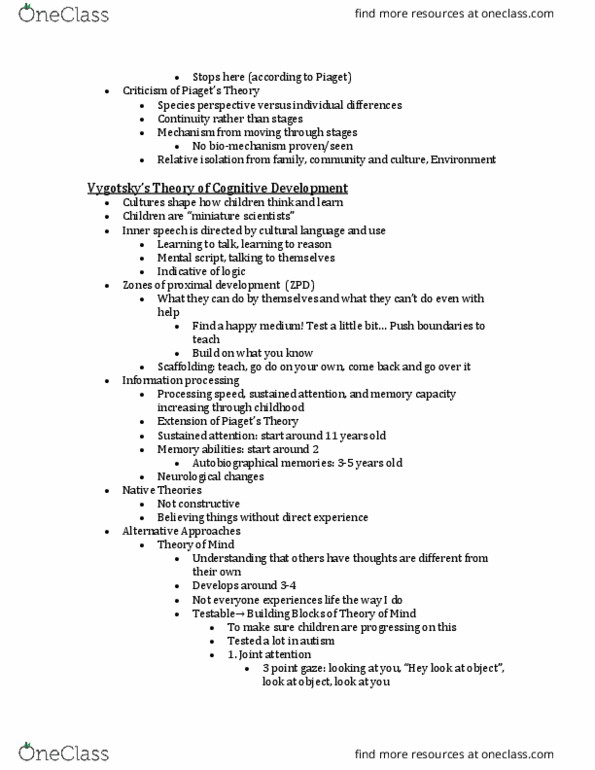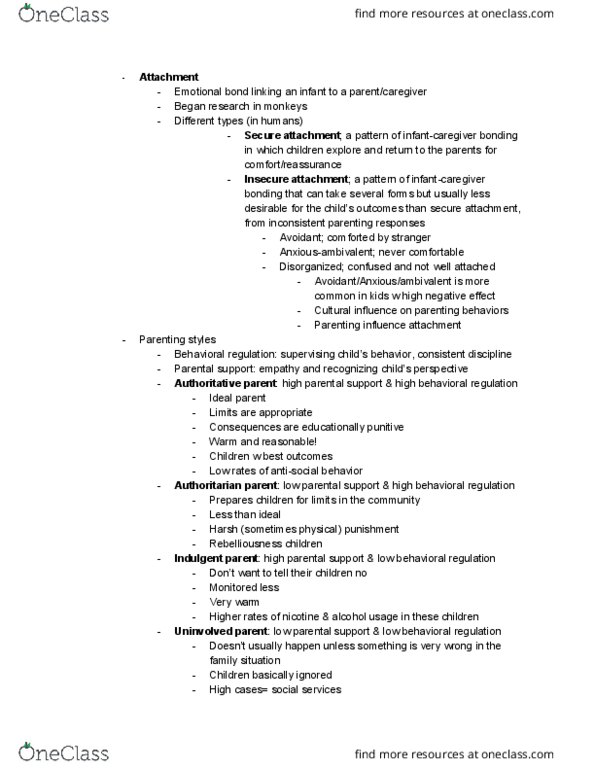PSYCH 1100 Lecture Notes - Lecture 22: Joint Attention, Information Processing
PSYCH 1100 verified notes
22/45View all

• Stops here (according to Piaget)
• Criticism of Piaget’s Theory
• Species perspective versus individual differences
• Continuity rather than stages
• Mechanism from moving through stages
• No bio-mechanism proven/seen
• Relative isolation from family, community and culture, Environment
Vygotsky’s Theory of Cognitive Development
• Cultures shape how children think and learn
• Children are “miniature scientists”
• Inner speech is directed by cultural language and use
• Learning to talk, learning to reason
• Mental script, talking to themselves
• Indicative of logic
• Zones of proximal development (ZPD)
• What they can do by themselves and what they can’t do even with
help
• Find a happy medium! Test a little bit… Push boundaries to
teach
• Build on what you know
• Scaffolding: teach, go do on your own, come back and go over it
• Information processing
• Processing speed, sustained attention, and memory capacity
increasing through childhood
• Extension of Piaget’s Theory
• Sustained attention: start around 11 years old
• Memory abilities: start around 2
• Autobiographical memories: 3-5 years old
• Neurological changes
• Native Theories
• Not constructive
• Believing things without direct experience
• Alternative Approaches
• Theory of Mind
• Understanding that others have thoughts are different from
their own
• Develops around 3-4
• Not everyone experiences life the way I do
• Testable→ Building Blocks of Theory of Mind
• To make sure children are progressing on this
• Tested a lot in autism
• 1. Joint attention
• 3 point gaze: looking at you, “Hey look at object”,
look at object, look at you
Document Summary
Stops here (according to piaget, species perspective versus individual differences, continuity rather than stages, mechanism from moving through stages, no bio-mechanism proven/seen, criticism of piaget"s theory. Vygotsky"s theory of cognitive development: children are (cid:498)miniature scientists(cid:499, cultures shape how children think and learn. Inner speech is directed by cultural language and use: learning to talk, learning to reason, mental script, talking to themselves, relative isolation from family, community and culture, environment, zones of proximal development (zpd) Indicative of logic: what they can do by themselves and what they can"t do even with, find a happy medium! Test a little bit push boundaries to: build on what you know teach help, scaffolding: teach, go do on your own, come back and go over it.





